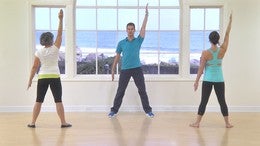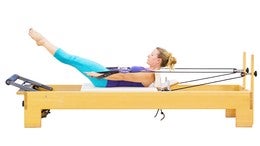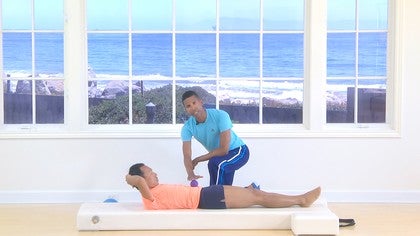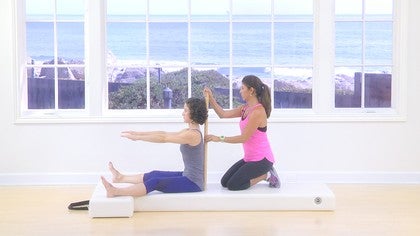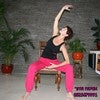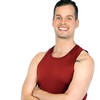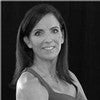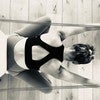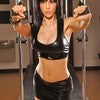Description
About This Video
Transcript
Read Full Transcript
Hi, I'm Benjamin Degenhart. I'm here with Christy Cooper and we'll be talking about the hundred. The hundred is probably the first exercise that you learn and you apply these practices, whether you're a teacher or practitioner. Um, it begins pretty much every workout you do, whether it's on the mat or on the reformer. And it's a really hard exercise. And, um, I wanted to spend some time breaking it down a little bit and trying to figure out why we do the exercise, why it is such a great start to your practice and how to build the strength to get the most out of the exercise. So one of the things I found remarkable when researching the history of the work and the evolution of the exercises is that the a hundred always stayed the same throughout over four decades of evolution, off control energy.
And I actually have the book right here. Um, and you probably have it as well if you're serious about you pull out these practice and, um, what you will see is that, um, there was really no, um, offering of a modification other than picking two straight legs off the ground just about two inches away from the ground, which is what we now consider the most advanced form of the exercise. But traditionally that was the only form of the exercise. So, um, the way I think about it is it might be worth investigating why that is, what the purpose might have been and um, how we can build a strength to perform the exercise the way it was originally intended. All right. Does that sound good? So let's, let's look at it first. So I'm Chris, why don't you go ahead. Lie Down with your head right here, legs long in front of you. Now, there are many different opinions whether the legs need to be turned out, um, or parallel. As far as the book goes, the only instruction was the legs are close together as possible. So you want to hug the midline with your legs, feel like there's no space for lighter air between them arms long by the sides and the elbows and knees. He addresses that they are locked. Now that doesn't mean necessarily extended and jamming into the joints and tons of tension, but there is a muscular effort around those joints to keep them straight.
Now from there we start with the legs. The legs lift up two inches away from the ground, the head, neck and shoulders lift the arms lift above the hips. That is the start position and you probably already feel the whole body's fired up in a flash sec. Now from there, the arms pump up and down, breathing in for five pumps and fully exhaling for five pumps and we'll take that up to a hundred inhaling and exhaling. Very good, and we'll just do a couple of more here because we'll probably do a few more of those today. Exhale all the air out. One more deep breath. Keep energy through the arms and legs. Exhale all the air out and then relax completely, which is my favorite instruction from the original book that acts completely great.
So one of the things you noticed when you try to do it exactly this way where the legs lift straight off the mat is that the lower back may or may not be okay with that, right? So, um, just pretend for a second that you don't know anything about polarities, right? And this might be your first time and start by again, squeezing your legs together strongly and just pick up your legs off the ground just about an inch or so. And start to notice how this entire area here starts to tense up. It might arch away from ground, they might be attention in the back that we don't really want, right? So what we're looking for in the exercise is not always necessarily linked to what muscles are working, right? So we, we think of the a hundred as an exercise that tones your abdominals, that gets your shoulders moving. That is about the breath.
And it's definitely all those things. But as far as the movement skill, we're trying to teach the body here. We're trying to lift weight off the ground, right? We try to lift half of our body weight, basically the legs and the torso and the arms off the ground, sustain that for the pumps. So, um, we're gonna try that again. She's going to squeeze the legs together. She thinks about unweighting her legs. So don't even lift them yet. Just try to make them a little bit lighter on the Mat and start to notice how this area starts to respond to that. Right? And I didn't tell her to pull her belly button to her spine.
It kind of happened automatically, right? So we'll explore that one more time. Unweight the legs, stretch them out of your body. Start to become aware of how this area starts to engage and then relax it completely. So now that we felt how the spine wants to react to the weight of the legs coming off the mat, we're going to anticipate that a little bit. So before the legs even come up, she's going to have that feeling of the ribs lengthening down into the mat, getting strong around the waist, and she stretches the legs out of her body to unweight the legs.
And then she picks them up as high as she needs to for a lower back to stay solid against the ground. And we're not gonna worry about the head at this point and then lower than that. Um, lowering it all the way back down. Let's do that one more time. She stretches the legs out of her body. She picks them up, the lower back is lengthening down in our position. That looks very solid. And then the legs come down from there. Right? And you can already tell, this is pretty much what we're looking for about 10 minutes in rural America as in teaser and in all the other exercise where we pick the legs off the ground, even one leg circle, rollover and so forth. So one more time, she's going to pick up the legs. This time she's also lifting her head, neck and shoulders up at the same time. All right?
Now the spine always moves as a whole. So even though we're trying not to tuck under, there is a little bit of a curve through the hips so that the spine Benz evenly to offset the way that just came off the ground. And then she slowly lowers that all the way back down. One more time, and then you're off the hook for a minute. All right. Stretch the legs out of your body. Pick up your head, neck and shoulders. Reach your arms, law and forward and away from you.
And this might be your exercise for a while until you can start adding the pumps and then we'll ax all the way down. Good. Nice. Now let's, let's talk about a couple of modifications that you can do if that is not available to you. And I'm going to try to stay away from offering a tabletop position because, um, tabletop is still a good way to get your abdominal stronger to get into the position that we want the spine to be in. But it doesn't really teach you how to pick up your legs, right? So, um, let's just say that we're staying with this modification bud. We're going to leave one leg down this time. So pick up your head, neck and shoulders. Stretch the right leg out of your body. Pick it up two inches away from the ground and hold that.
Now without lifting your left leg. Can you unweight it a little bit? Oh, nice. And then relax it all the way back down. So that's something you could do, right? Let's do the other side just to be even had nick controllers curl up the left leg out of your body. Reach long through your fingertips and make this right leg a little bit lighter on the Mat. Yes. Good. And slowly come all the way back down. All right, so now that we know what we're looking for in the exercise, let's talk a little bit about how we can modify it. Because yeah, just picking your legs up two inches off the ground may not be successful right away. And the second year, lower back starts to protest against that.
We want to have some systems in place that'll help us modify the exercise. Right? But, um, what is typically done, and I'm just going to address it for a minute, um, is that we bring the legs into a tabletop position to shorten the lever of the legs. Meaning there's less way that we have to manage from, from the core. Um, however, what this does not do is teach you how to pick up the weight of your legs, right? So, um, know that this is always there. If you're injured, if you have a reason to use this as a modification, it's always there. There's a place for it. Um, but we'll try to stay true to what the purpose of the exercises, which is to learn to live two straight legs off the ground. So we can do that later in the teaser. Alright, so stretch your legs right back out. And one of the first things where we can start modifying the exercise is instead of two legs lifting up, we'll just do one. All right?
So just make it right like super long at this time. Stretch it out of your body and pick it up just a couple of inches off the ground. Making sure that the left leg is also somewhat light on the ground as well. Now pick up your head, neck and shoulders. Stretch your arms forward and up and you could start your pumps right there and just do a set of one deep breath in and fully exhaling, reaching the legs out of the body. Hold that there.
Now see if you can unweight this leg just a little bit more without lifting it up and see if that changes the configuration of your spine. I saw that and then relax it all the way down and just to be even. Let's do the other side as well. So she stretches the left leg out of her body. She curls her head, neck and shoulders up, and she pumps on deep breath here and exhaling. Now as I saw that, did you read my mind there and slowly release all the way down. Good. And I mentioned it before. Of course, the leg can come up way higher if that's required, right?
If that all goes well and you're willing to try it with two legs and we'll just have to do it one more time. She's going to press her legs together. She curls head, neck and shoulders up, stretches the legs out of her body. Now let them come up way high. Say 45 maybe higher than that. The higher your legs are, the more easy it will be to hold the weight of your legs because it just plum line straight down into your hips at 90 anything lower than that will be much, much harder to hold. So you find your own level of strength where you have full support, right?
So that's another modification. Bring the legs all the way down, release your head back. Take an inhale, stretch the legs out of your body, pick them up, curl yourself up and find your level of strength. And for her that's going to be fairly low because she is very strong. Deep breath in and exhaling. Inhale and exhale. We'll just take one more breath. We've seen it many times now already, but she does it so beautifully.
I just want to see it again. Exhale all the air out and then release all the way down. Now he has the most obvious modification and it's actually in the book in Joseph [inaudible] Book. If you can only do 20 to start, that's where you start. You work on two breaths, then you work on 21 repetitions and 22 and you work your way up to a hundred so you already have a progression for four beginner's skill, a hundred and intermediate skill, a hundred and in advance, which would be a 400 all right, so those are the modifications that are available to you to do the a hundred on the mat. So let's talk about the pumps for a second. We sort of talked about that you can just bring your body into the position to start and really learn what it takes to pick up most of your torso, all of your legs of the ground, and just hold that, that that is a great exercise in and of itself because that really replicates the skill we need in your rollover and all those other exercises.
Teaser named the exercise. All of them have some version of the a hundred in them. Um, but then once you're ready, you want to start adding the pumps. Now what are the pumps for? Um, then not really big enough movement to 'em to turn them into an arm exercise where we not necessarily toning the triceps here, even though it's clearly working. Um, the fluttering action of the arms is really just there to challenge the stability of the spine, right? So once you brought yourself up into the position, the spine has to perpetually create enough stability to manage the weight of your legs. And with every pump you challenge that, right? So it makes it incredibly hard. Um, so let's add that in and let's make that very vigorous, right?
The Way Joe won it. So you carry yourself up into your position by now, you know that, and then you start pumping strongly, inhaling and exhaling. Now she pumps the arms six to eight inches above the hips, nice and high. Good. And she exhales. Now it's, and you can keep your arms a little bit wider, as wide as the hips there. That's it. And exhale, one more deep breath. Inhale, she acts out all the air out and she released this completely from there. So finally, let's talk about the breathing. Big Portion of this exercise it is, is a rhythmic breath. We inhale for five pounds. We are here for five pumps. It gets very confusing for a lot of people. Um, the reason we want to breathe rhythmically is to really have a chance to expand on our breathing in more air, expel more air with each repetition.
So we have, um, a measurement in, in how long each inhale takes and to see can we expand on that breath. Um, traditionally we breathe in through the nose and out through the nose. The nose, um, houses the filtration system of the body, so it's a more effective and purifying way to breathe. Um, however, when the going gets tough, we, we tend to outhill through the mouth. Um, because it's a bigger cavity, it's a little bit easier to exhale that way. Um, however, we'll try, especially since we're just starting our workout with a hundred to inhale and exhale through the nose the entire time. So let's see how that goes. All right, so bring us up up into your hundred position. Beautiful and start pumping vigorous arms. Inhaling for five and Oh Haley, exhaling for five deep inhale and exhale all the air. And now keep on going and start to notice whether it can be a full exhale without any constriction in the throat. Because that is also going to tell you whether you bring your trigger to your chest too far, whether you have enough space through the chest as you currently the entire spine up and forward. Let's just take one more deep breath. Inhale, think you've done about 350 pumps by now.
XLR the air out and relax completely. And that's your a hundred on the mat. Should we take this to the reformer next? All right, let's do it. So here we are on the reformer during the same exercise. Um, what the springs will magnify is the effort that it takes to, to move your arms because of the straps. We'll pull back on your hands. Um, we have spring tension underneath us. So, um, it'll hopefully teach us something about the lift because that's what the reform that was there for it. Right? So teach you something about the way you move. So, um, we're working with full springs in this exercise. It is a warm up still. Um, we've just done a footwork if we do the traditional reformer, but this is now the exercise that really gets you started. Um, just reach behind your shoulder box, pick up your handles and straighten your arms all the way up. Um, one of the things I like to do to sort of feel how the spring and strap tension feeds into our body and the way we move is to just get a really good strong fist grip Joe style on the handles.
And then just releasing the straps ever so slightly. So the arms reach back a little bit and then you just move your arms forward until you find your strap tension. So you pull into attention without moving the springs yet, and then you release that again and again moving the arms forward until the scraps are taught. And that sort of incentivize the body to find that first little bit of stability, right? Because there's a load coming in. So do that again and see if beyond your arms and shoulders it's settled somewhere in your spine as well.
See if you can find some sort of bracing sensation around the rib cage somewhere there. It kind of happens automatically, right? So we'll do that one more time. And then the same exact lift of the legs applies as on the mat. She unweighted the lady, she picks them up off the foot bar, pulls down on the straps, lifting herself into the position, and then the movement is exactly the same. So pumping vigorously, breathing in for 5:00 AM breathing out for five. Good. Now move the arms quickly. This is a little bit unlike most other, um, exercises, especially on the mat as well, where we moved very quickly instead of slow and sustained. Now continue to reach the legs out of your body.
Ungrip the friends of your hips. Yes, and exhale deep. Inhale and exhale. So same exercise. We're going to make her do a full hundred here. Breathe in and exhale. Now I notice a little constriction in her breathing here. So see if you can change the curve of your spine to have more space for your neck and your breath. Good. Inhale, that looks much better.
And XL, I'll give me one more. Good pump in here. Isley done XR two, three, four, five and release down now. So what the springs add, as I said before, is really just to magnify how much effort it takes to work through the upper body. But it also assists the exercise somewhat, right? The teachers, it's something about the quality of the lift. Oh, right. So you see it's the same exercise. The only thing that's different is that because the spring tension is pulling on the arms and it magnifies the effort a little bit, it takes for the upper body to sustain the curl as the weight of the legs comes up. But other than that, it's really the same exercise. And it also somewhat assists the exercise, right?
Remember that the reformers sort of teaches your body how to move away from it as well. Um, so you're all set with the 104. Now. Um, let me just recap a little bit of what I want you to practice, um, or take into your practice next time you get to do the a hundred. Um, think about the movement in 10 being less about the muscular effort and the fact that your abdominals and your inner thighs are working. All of that is there. Um, think of it as a side effect and things that the actual purpose of the exercise is to learn how to lift your body weight against gravity and to hold it from the central body. Make sure that as you curl your chest up and forward, you have enough space for your breathing. Don't worry about the pumps right away. Make sure that you have a strong solid position first before you add the pumps in if your teacher allows you to. That is, um, and just keep exploring.
The Pilates Essentials: Exercise Breakdown Tutorials
Comments
Thank you.
You need to be a subscriber to post a comment.
Please Log In or Create an Account to start your free trial.

